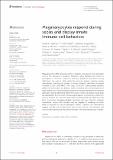Megakaryocytes respond during sepsis and display innate immune cell behaviors
Author(s)
Frydman, Galit H.; Ellett, Felix; Jorgensen, Julianne; Marand, Anika L.; Zukerberg, Lawrence; Selig, Martin K.; Tessier, Shannon N.; Wong, Keith H. K.; Olaleye, David; Vanderburg, Charles R.; Fox, James G.; Tompkins, Ronald G.; Irimia, Daniel; ... Show more Show less
Downloadfimmu-14-1083339.pdf (3.212Mb)
Publisher with Creative Commons License
Publisher with Creative Commons License
Creative Commons Attribution
Terms of use
Metadata
Show full item recordAbstract
Megakaryocytes (MKs) are precursors to platelets, the second most abundant cells in the peripheral circulation. However, while platelets are known to participate in immune responses and play significant functions during infections, the role of MKs within the immune system remains largely unexplored. Histological studies of sepsis patients identified increased nucleated CD61+ cells (MKs) in the lungs, and CD61+ staining (likely platelets within microthrombi) in the kidneys, which correlated with the development of organ dysfunction. Detailed imaging cytometry of peripheral blood from patients with sepsis found significantly higher MK counts, which we predict would likely be misclassified by automated hematology analyzers as leukocytes. Utilizing in vitro techniques, we show that both stem cell derived MKs (SC MKs) and cells from the human megakaryoblastic leukemia cell line, Meg-01, undergo chemotaxis, interact with bacteria, and are capable of releasing chromatin webs in response to various pathogenic stimuli. Together, our observations suggest that MK cells display some basic innate immune cell behaviors and may actively respond and play functional roles in the pathophysiology of sepsis.
Date issued
2023-03-02Department
Massachusetts Institute of Technology. Division of Comparative Medicine; Massachusetts Institute of Technology. Department of Biological EngineeringPublisher
Frontiers Media SA
Citation
Frydman, Galit H., Ellett, Felix, Jorgensen, Julianne, Marand, Anika L., Zukerberg, Lawrence et al. 2023. "Megakaryocytes respond during sepsis and display innate immune cell behaviors." 14.
Version: Final published version
ISSN
1664-3224
Keywords
Immunology, Immunology and Allergy